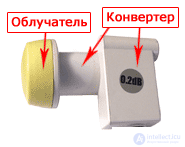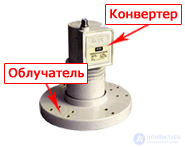Lecture
Converters ("LNB" or "LNA"), as well as a radio signal, are divided into the reception of a specific frequency spectrum, that is, again, the range.
- abbreviated name LNB (Low Noise Blockconvertor). "Low" - low, "Noise" - noise, "Blockc-onvertor" - block converter. The domestic name of the LNA converter is the Little Noisy Device.
You may encounter such a designation of converters, LNB or LNBF - in principle, the correct name is both. But if we take into account that converters going to offset satellite antennas have an integral housing with an irradiator ( Photo 1 ), then it would be more correct to use the name - LNBF ( LNB - converter, + F eeder - feeder, i.e. receiving antenna, or irradiator = LNBF ).

Photo 1 Satellite Ku-band converter (converter with an irradiator in one package - LNBF).
There are types of converters where the irradiator is attached to the converter housing, and they are usually assembled before being mounted on a satellite dish . In this case, the name LNB + F will be more correct (LNB is a converter, + Feeder is an irradiator).

Photo 2 Satellite converter C-band (the emitter is attached to the body of the converter - LNB + F).
Satellite converters, which are usually used to view a home satellite broadcast, to the article and not only, are also designed for reception: C- band , Ku , or combined C and Ku -band.
Ku- Band satellite converters are more common, since the diameter of a satellite dish , when using such a converter, is usually from 0.5 to 1.2 meters. When receiving a C- band, the size of the antenna requires a bit more.
For example, you can use a satellite antenna with a diameter of 0.9 - 1.2 meters to receive a Ku- band signal from the Yamal 201 201 satellite, and it is advisable to use an antenna of at least 1.5, preferably 1.8 or better, to receive the C -band from the same satellite. 2.0 meters.
Note: the sizes of satellite antennas are given only roughly, how to calculate a more accurate parameter of it, consider a little later.
There are many models of satellite converters, different in type and appearance. Below are photos of some of them.

Single Output Satellite Converter

Satellite converter with two outputs

Satellite converter
C - range

Combined satellite converter C and Ku - range
In addition to the frequency spectrum (range), converters, again, like the radio signal, differ in the type of signal polarization. And in one converter there can be two types of polarization at once.
Here are two basic types of converters that you may encounter:
one.
(Universal) - in this type of converter there are two types of polarization:
Linear horizontal ( H - Horisontal).
Linear vertical ( V - Vertical).
2
(Circular) - in this type of converter there are also two types of polarization:
Circular right ( R - Right).
Circular left ( L - Leftl).
In the name of the circular satellite converter, the word “universal” may also occur, since it contains two types of polarization “right” and “left”, but ... do not confuse it with a linear converter.
Converters can also be single- and dual-band. Dual-band converters capture a slightly larger portion of the frequency spectrum. Controls the switching of the ranges, the satellite receiver itself (it sends a special tone to the converter).
A selection of the type of satellite converter, so to say, an individual approach, and each user selects it in accordance with their requirements. That is, under the type of signal that he is going to receive from the satellite. Also, you should pay attention to the number of receivers (for example, a converter with two outputs to two receivers located in different rooms, well, or the receiver and computer DVB-card, etc.).
About some use of satellite converters, as well as some aspects of its principle of operation, I will also discuss the installation and configuration of a satellite dish, that is, during the installation and configuration of a satellite dish .
Comments
To leave a comment
The television. Theory. Satellite
Terms: The television. Theory. Satellite